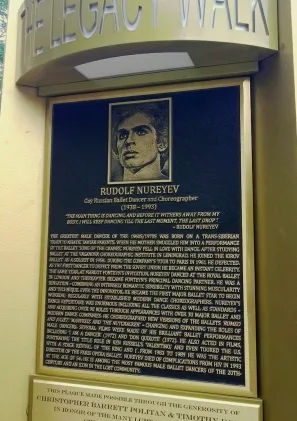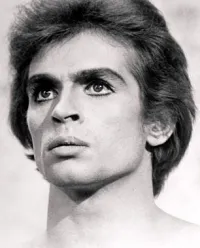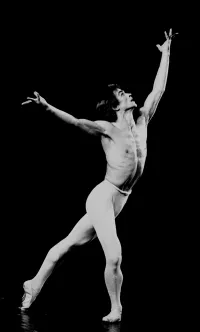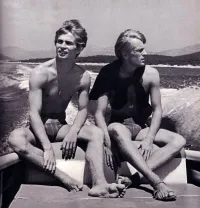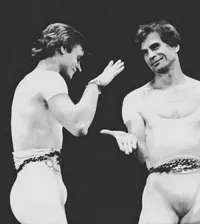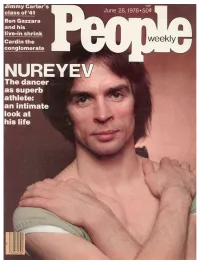Biography
1938 - 1993
“The main thing is dancing, and before it withers away from my body, I will keep dancing till the last moment, the last drop.”
– Rudolf Nureyev
The greatest male dancer of the 1960s/1970s was born on a Trans-Siberian train to Asiatic Tartar parents. When his mother smuggled him into a performance of the ballet ‘Song of the Cranes,’ Nureyev fell in love with dance. After studying ballet at the Vaganova Choreographic Institute in Leningrad, he joined the Kirov Ballet as a soloist in 1958. During the company’s tour to Paris in 1961 he defected. As the first dancer to defect from the Soviet Union he became an instant celebrity. The same year, at Margot Fonteyn’s invitation, Nureyev danced at the Royal Ballet in London and thereafter became Fonteyn’s principal dancing partner. He was a sensation – combining an intensely romantic sensibility with stunning muscularity and technique. Ever the innovator, he became the first major ballet star to begin working regularly with established modern dance choreographers. Nureyev’s dance repertoire was enormous including all the classics as well as standards – and acquiring over 90 roles through appearances with over 30 major ballet and modern dance companies. He choreographed new versions of the ballets ‘Romeo and Juliet,’ ‘Manfred,’ and ‘The Nutcracker’ – changing and expanding the roles of male dancers. Several films were made of his brilliant ballet performances including ‘I Am a Dancer’ (1972) and ‘Don Quixote’ (1972). He also acted in films, portraying the title role in Ken Russell’s ‘Valentino,’ and even toured the U.S. with a stage revival of ‘The King and I.’ From 1983 to 1989 he was the artistic director of the Paris Opera Ballet. Nureyev died of complications from HIV in 1993 at the age of 54. He is among the most famous male ballet dancers of the 20th-century and an icon in the LGBT community.
1938 - 1993
“The main thing is dancing, and before it withers away from my body, I will keep dancing till the last moment, the last drop.”
– Rudolf Nureyev
The greatest male dancer of the 1960s/1970s was born on a Trans-Siberian train to Asiatic Tartar parents. When his mother smuggled him into a performance of the ballet ‘Song of the Cranes,’ Nureyev fell in love with dance. After studying ballet at the Vaganova Choreographic Institute in Leningrad, he joined the Kirov Ballet as a soloist in 1958. During the company’s tour to Paris in 1961 he defected. As the first dancer to defect from the Soviet Union he became an instant celebrity. The same year, at Margot Fonteyn’s invitation, Nureyev danced at the Royal Ballet in London and thereafter became Fonteyn’s principal dancing partner. He was a sensation – combining an intensely romantic sensibility with stunning muscularity and technique. Ever the innovator, he became the first major ballet star to begin working regularly with established modern dance choreographers. Nureyev’s dance repertoire was enormous including all the classics as well as standards – and acquiring over 90 roles through appearances with over 30 major ballet and modern dance companies. He choreographed new versions of the ballets ‘Romeo and Juliet,’ ‘Manfred,’ and ‘The Nutcracker’ – changing and expanding the roles of male dancers. Several films were made of his brilliant ballet performances including ‘I Am a Dancer’ (1972) and ‘Don Quixote’ (1972). He also acted in films, portraying the title role in Ken Russell’s ‘Valentino,’ and even toured the U.S. with a stage revival of ‘The King and I.’ From 1983 to 1989 he was the artistic director of the Paris Opera Ballet. Nureyev died of complications from HIV in 1993 at the age of 54. He is among the most famous male ballet dancers of the 20th-century and an icon in the LGBT community.
Lesson Plan
Please login or register for an account to view this lesson plan.
Demography
Demography
Gender Male
Sexual Orientation Gay
Gender Identity Cisgender
Ethnicity Caucasian/White
Nations Affiliated Austria France Russia United Kingdom
Era/Epoch AIDS Era (1980-present) Cold War (1945-1991) Information Age (1970-present) Soviet Union (1922-1991)
Field(s) of Contribution
Art, Music, Literature & Theater
Dance
Film
Media & Communications
Social Sciences
Television
Theater
US History
World History
Commemorations & Honors
Rudolf Nureyev's Name Reentered in the History of Mariinsky Ballet in St Petersburg; Russia
Permanent Collection of Nureyev's Costumes at Centre National du Costume de Scene in Paris (2013)
Demography
Gender Male
Sexual Orientation Gay
Gender Identity Cisgender
Ethnicity Caucasian/White
Nations Affiliated Austria France Russia United Kingdom
Era/Epoch AIDS Era (1980-present) Cold War (1945-1991) Information Age (1970-present) Soviet Union (1922-1991)
Field(s) of Contribution
Art, Music, Literature & Theater
Dance
Film
Media & Communications
Social Sciences
Television
Theater
US History
World History
Commemorations & Honors
Rudolf Nureyev's Name Reentered in the History of Mariinsky Ballet in St Petersburg; Russia
Permanent Collection of Nureyev's Costumes at Centre National du Costume de Scene in Paris (2013)
Resources
Resources
Kavanagh, Julie. Nureyev: The Life. New York: Vintage, 2008.
Nureyev, Rudolf. An Autobiography. London: Holder and Stoughton, 1962.
Solway, Diane. Nureyev: His Life. New York: William Morrow, 1998.
http://www.notablebiographies.com/Ni-Pe/Nureyev-Rudolf.html
https://www.theguardian.com/stage/2003/jan/30/dance.artsfeatures
Resources
Kavanagh, Julie. Nureyev: The Life. New York: Vintage, 2008.
Nureyev, Rudolf. An Autobiography. London: Holder and Stoughton, 1962.
Solway, Diane. Nureyev: His Life. New York: William Morrow, 1998.
http://www.notablebiographies.com/Ni-Pe/Nureyev-Rudolf.html
https://www.theguardian.com/stage/2003/jan/30/dance.artsfeatures
